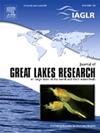lampricide 3-三氟甲基-4-硝基苯酚(TFM)以剂量依赖的方式刺激海七鳃鳗幼虫的耗氧
IF 2.5
3区 环境科学与生态学
Q3 ENVIRONMENTAL SCIENCES
引用次数: 0
摘要
海七鳃鳗(Petromyzon marinus)是劳伦森五大湖的一种入侵物种,在20世纪初中期,吸血七鳃鳗幼鱼的寄生极大地减少了经济和文化上重要的本地鱼类的数量。为了控制海七鳃鳗的数量,将三氟甲基-4-硝基苯酚(TFM)添加到有海七鳃鳗幼虫出没的溪流中。与大多数非目标鱼类相比,海七鳃鳗对TFM的解毒能力较低,使其成为一种高效的杀虫剂。TFM通过破坏线粒体中的氧化磷酸化来减少ATP的产生,导致线粒体耗氧量增加。然而,人们对TFM如何影响海七鳃鳗和其他鱼类的全动物耗氧量知之甚少。为了验证TFM对海七鳃鳗幼鱼代谢率具有剂量依赖性的假设,我们使用间歇流呼吸法测量了TFM暴露期间海七鳃鳗幼鱼的质量比耗氧率(ṀO2)。暴露于不断增加的TFM浓度导致海七鳃鳗幼体ṀO2逐步增加,在ṀO2达到相当于其已知最大代谢率的水平后导致死亡。可以使用ṀO2的类似测量来确定非目标物种对TFM的相对敏感性,以便更好地评估TFM对居民渔业的潜在影响。本文章由计算机程序翻译,如有差异,请以英文原文为准。

The lampricide 3-trifluoromethyl-4-nitrophenol (TFM) stimulates oxygen consumption by larval sea lamprey in a dose-dependent manner
Sea lamprey (Petromyzon marinus) are an invasive species in the Laurentian Great Lakes, where parasitism by blood-feeding juvenile lampreys greatly reduced populations of economically and culturally important native fishes in the early-mid 1900s. To control sea lamprey populations, the lampricide 3-trifluoromethyl-4-nitrophenol (TFM) is added to streams infested with larval sea lamprey. Sea lamprey have a lower capacity to detoxify TFM than most non-target fishes, making it a highly effective pesticide. TFM decreases ATP production by disrupting oxidative phosphorylation in the mitochondria, leading to an increase in mitochondrial oxygen consumption. However, little is known about how TFM affects whole animal oxygen consumption in sea lamprey and other fishes. To test the hypothesis that TFM has dose-dependent effects on larval sea lamprey metabolic rate, we measured the mass-specific oxygen consumption rates () of larval sea lamprey using intermittent-flow respirometry during TFM exposure. Exposure to increasing concentrations of TFM led to stepwise increases in in larval sea lamprey, resulting in death after reached levels equivalent to their known maximum metabolic rates. Similar measurements of could be used to determine the relative TFM sensitivity of non-target species to better assess the potential impacts of TFM on resident fisheries.
求助全文
通过发布文献求助,成功后即可免费获取论文全文。
去求助
来源期刊

Journal of Great Lakes Research
生物-海洋与淡水生物学
CiteScore
5.10
自引率
13.60%
发文量
178
审稿时长
6 months
期刊介绍:
Published six times per year, the Journal of Great Lakes Research is multidisciplinary in its coverage, publishing manuscripts on a wide range of theoretical and applied topics in the natural science fields of biology, chemistry, physics, geology, as well as social sciences of the large lakes of the world and their watersheds. Large lakes generally are considered as those lakes which have a mean surface area of >500 km2 (see Herdendorf, C.E. 1982. Large lakes of the world. J. Great Lakes Res. 8:379-412, for examples), although smaller lakes may be considered, especially if they are very deep. We also welcome contributions on saline lakes and research on estuarine waters where the results have application to large lakes.
 求助内容:
求助内容: 应助结果提醒方式:
应助结果提醒方式:


